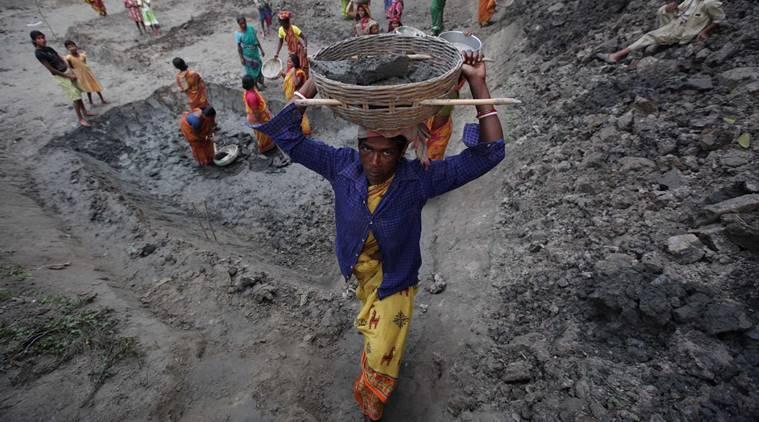Demand For MGNREGA Jobs Highest in Eight Years

Image Coutesy: The Indian Express
Prime Minister Narendra Modi has time and again dismissed the Mahatma Gandhi National Rural Employment Guarantee Act (MGNREGA) as the “living monument of United progressive Alliance’s (UPA) failure”.
However, according to a report in The Indian Express, the last year of National Democratic Alliance (NDA) government shows a marked increase in the demand for jobs under MGNREGA, serving as an indicator of rural distress.
Official data show that in 2018-19, the demand for work increased by almost 10% compared to the previous year and also registered the highest number of person-days of work under the scheme since 2010-11.
The work generated under MGNREGA as per this financial year- up to March 25, was 255 crore person-days with the numbers expected to go even higher. Against this, the scheme generated 233 crore person-days in 2017-18 and 235 person days in 2016-17 and 2015-16, each.
Under the scheme, the unit of one person-day is generally taken to be eight hours of work and in 2014-15, the first year under the NDA government, the person-days generated was just 166 crore.
Government officials, responsible for implementing the scheme, attribute the spurt to the increase in the frequency of climate-change related incidents such as drought or floods that lead to a loss of the mainstay farm incomes. However, those monitoring the scheme on the ground state that the increased uptake of MGNREGA work also reflects the overall situation of unemployment.
Also Read: Slowing Economy, Rising Joblessness
MGNREGA is a flagship demand-driven social security scheme that creates direct wage employment for 100 days of work per rural household with the number of work-days allowed to be increased to 150 annually in case of drought, flood or a similar calamity.
Though under attack from the prime minister in the initial years, it now seems to have the government’s approval. As per the report in The Indian Express, Nikhil Dey from the Mazdoor Kishan Shakti Sangathan (MKSS) pointed out that in the face of unemployment and drought, people will take up any job that opens up. “Owing to joblessness, there is a massive demand for MGNREGA work but the provision of work was often restricted due to inadequate funds being allotted for the scheme by the Finance Ministry. The recent increase in person-days reflects that the government has finally acknowledged this demand,” he said.
Nearly a quarter of districts in the country have declared drought, leading to a higher demand for MGNREGA jobs. Jharkhand, with one of the country’s lowest MGNREGA pay of Rs 168 per day, has declared drought in 18 of its 24 districts. Additional work – due to droughts in Karnataka, Rajasthan, Odisha, Maharashtra, Gujarat, and Andhra Pradesh and floods in Kerala and Gaja cyclone-hit Tamil Nadu – had to be provided under the MGNREGA scheme.
The report further stated that MGNREGA researchers believe that the agrarian crisis was really acute in the last one year and there has been no alternate source of employment anywhere. The budget allotment for the scheme was also abysmal just like in last four years but considering the extent of the crisis, states such as Karnataka started using their own funds to offset lack of funds from the Centre.
Also Read: Elections 2019: Jobs Failure Will Sink Modi
According to an analysis on state budgets for rural development by Centre for Budget and Governance Accountability: CBGA India, funds allocated for schemes like MGNREGA and PMAY-G are inadequate in proportion to the demand from the districts and most districts are running a negative balance in their accounts owing to pending liabilities. Inadequate information regarding convergence of MGNREGA with other schemes leads to delays in fund flow and subsequently, quality of fund utilisation suffers.
Further, although the gross allocations for MGNREGA have increased from Rs. 32,969 crore in Financial Year 2014-15 (A) to Rs. 61,084 crore in 2018-19 (Revised Estimate), the allocations have actually declined when adjusted for inflation. On paper, there is a 25% increase in allocation under MGNREGA between 2016-17 (Budget Estimate) and 2017-18 (BE), but the allocations for 2017-18 (BE) have decreased when we account for two supplementary allocations in FY 2016-17 that took the total spending in 2016-17 (A) to Rs. 48,215 crore.
Likewise, even though the Parliament passed a supplementary budget of Rs. 6,048 crore on January 15, 2019, further enhancing allocations up to Rs. 61,084 crore for 2018-19 (BE) – which is considered to be the highest allocation ever – the net allocation is far lower than Rs. 55,000 crore allocated in 2017-18 (RE), when adjusted for inflation.
Get the latest reports & analysis with people's perspective on Protests, movements & deep analytical videos, discussions of the current affairs in your Telegram app. Subscribe to NewsClick's Telegram channel & get Real-Time updates on stories, as they get published on our website.
























